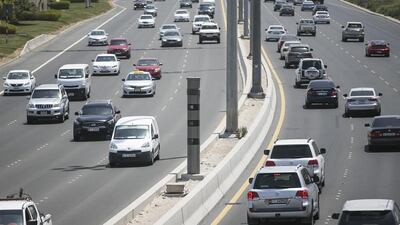ABU DHABI // More measures have been introduced to improve the UAE’s roads, but driving behaviour is the main hurdle to cutting accidents, say experts.
Phil Clarke, principal road safety consultant at Transport Research Laboratory – UAE, said road improvements do have an effect on safety.
“If improvements are good, generally what would happen is that likely can reduce congestion, if it’s related to capacity. That, in turn, reduces the amount of driver frustration,” he said. “And driver frustration, of course, can lead to irresponsible behaviour: swerving from lane to lane, cutting people out, hard shoulder running, all that sort of thing.”
Sometimes, however, improvements can have adverse effects on driving.
“The downside is that very often, after improving a road, you increase the ability for people to travel quickly,” he said.
Last month, the Abu Dhabi Executive Committee approved plans to manage and improve traffic flow on Sheikh Zayed bin Sultan Street.
Another section at one of the traffic junctions will be added, while Al Dhafeer Street will be expanded, creating bigger breakdown lanes and new entrances to streets around Al Bahr Towers.
“In terms of road-widening, you improve the conditions but there are environmental considerations as well as the tendency of people to drive faster,” said Sonal Ahuja, regional director of PTV Group, which provides software and consultancy services for traffic and transport planning.
“People will start driving faster because the road is wider, but we should enforce speed-calming measures so people won’t drive erratically.”
The UAE Government has made significant investments to road infrastructure and implementing intelligent transport systems to enhance safety and ease congestion.
“Safer roads speak for themselves and better infrastructure results in reduced traffic jams, which is a big contributor to road safety since many motorists start to violate rules when they are caught in a tailback,” said Thomas Edelmann, founder of Road Safety UAE.
“We see bullying, jumping queues, using the hard shoulder and other misbehaviour in traffic jams that can potentially result in accidents, injuries and fatalities.”
A smart traffic system will be used to control the number of vehicles that join Sheikh Zayed bin Sultan Street, based on the motorway's capacity, the Department of Municipal Affairs and Transport said last month.
Vehicle counting and classification sensors and cameras will be used to monitor congestion levels.
Speed bumps and other measures to slow traffic will be installed across the capital over the next two years to reduce speed-related accidents, Abu Dhabi Municipality announced in July.
“We have a very competitive driving culture here in the UAE,” Mr Clarke said. “It’s not just about the fact that people speed, it’s the differential between the speeds that causes the big problem. You’ve got somebody travelling at 80kph, somebody bearing down on them behind at 120 or 140kph. If that individual who’s doing 80kph changes lanes or somebody else carries out a manoeuvre, it forces the one travelling so quickly to have to deal with the situation. Very often, they can’t, and it’s the speed differential that I see when I’m driving around that causes the most problems. It’s where all the swerving comes from because people will take abrasive actions when changing lanes.”
The Mafraq-Ghuwaifat road project, which is more 70 per cent completed, is projected to increase capacity and safety significantly.
It includes the construction of 16 interchanges, the improvement of interchanges in Mafraq, Hameem, Abu Al Abyad and Madinat Zayed, and construction of lanes in both directions for the roads between Mafraq and Baynounah forest area and between Baraka and Ghuwaifat.
“If you take this road improvement project, one of the main things is the increased number of lanes,” Mr Clarke said.
“Hopefully it will help to separate the heavy truck traffic from the other traffic a bit more. Because at the moment, with two lanes, you’ll either be among the lorries or you’re out in the inner lane, with someone bearing down on you from behind, less than a metre from your bumper flashing his lights.”
rruiz@thenational.ae

